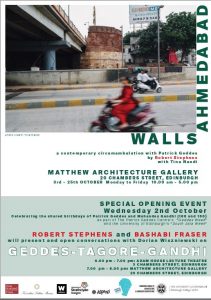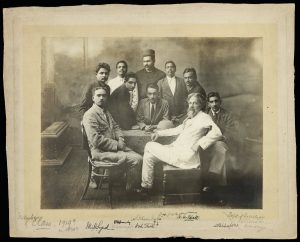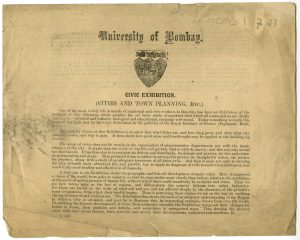This October we celebrate the 165th anniversary of Patrick Geddes’ birth (2 October 1854). We bring you news of a series of upcoming events which commemorate Patrick Geddes and his long-standing relationship with India.
We are popping up! We are offering a unique opportunity to view material from the Patrick Geddes Archives held by both the Universities of Edinburgh and Strathclyde. Two small complementary displays are available to view at the University of Edinburgh Main Library and the University of Strathlcyde Andersonian Library (levels 3 and 5). Planning for Humanity: Patrick Geddes in India, 1914-1924, celebrates Geddes’ unique contribution to urban planning in India.
Both displays will run throughout October 2019 and are available to view by staff, students and members of the public, between 9am-5pm, Monday to Friday. If you are a member of the public, simply let staff at the front desk of the library you are visiting know that you are interested in viewing the display and you will be issued with a temporary visitors pass. Please note that at the University of Edinburgh Library you will be required to provide photographic ID in order to gain access to the library and view the display.
 Congratulations to colleagues at Edinburgh Global who have compiled a fantastically full and varied programme as part of the University of Edinburgh’s South Asia Week 2019. Do not miss the Ahmedabad Walls exhibition! This is a unique opportunity see the history of Ahmedabad through the eyes of Mumbai based architect and aerial photographer Robert Stephens. Stephens’ aerial photography references Patrick Geddes’ 1915 observations of the historic walled city, and features excerpts from archive material from the Patrick Geddes archives and from Stephens’ own collections.
Congratulations to colleagues at Edinburgh Global who have compiled a fantastically full and varied programme as part of the University of Edinburgh’s South Asia Week 2019. Do not miss the Ahmedabad Walls exhibition! This is a unique opportunity see the history of Ahmedabad through the eyes of Mumbai based architect and aerial photographer Robert Stephens. Stephens’ aerial photography references Patrick Geddes’ 1915 observations of the historic walled city, and features excerpts from archive material from the Patrick Geddes archives and from Stephens’ own collections.
Robert Stephens first visited Scotland to research the Patrick Geddes archives in June 2018. During his visit, a chance conversation with our project archivist, Elaine MacGillivray, led to the two collaborating on two events in March 2019, in India. Thanks to funding from generous University of Edinburgh alumni, Elaine travelled in the footsteps of Geddes, highlighting the Patrick Geddes archives and sharing project news with passionate and enthused audiences in both Ahmedebad and Mumbai. You can view Elaine’s CEPT University talk on YouTube.
a selection of images from elaine and robert’s collaborative patrick geddes events with CEPT UNIVERSITY, Ahmedbad and artisan’s gallery, mumbai, which took place in March 2019. Images Courtesy of ROBERT STEPHENS AND Tina Nandi.
The University of Edinburgh’s South Asia Regional Director Amrita Sadarangani aided the success of Elaine’s visit to India enormously. One afternoon, in the beautiful Ministry of New offices in Mumbai, Amrita and Elaine sat together discussing potential “Geddes inspired” collaborations. Amrita suggested that we connect Stephens with our very own School of Architecture colleague, Dr Dorian Wiszniewski. Subsequently, and after a lot of hard work behind the scenes, we are thrilled that this October will see the opening of Ahmedebad Walls at the Matthew Architecture Gallery in Edinburgh. Thanks go to everyone who has helped to make it happen.

“Ahmedabad Walls” Exhibition Poster
Robert Stephens and Professor Bashabi Fraser (Edinburgh Napier University) will be in conversation with Dr Dorian Wiscniewski on the evening of 2 October 2019. Set to be a fascinating discussion, which covers Geddes,Tagore and Gandhi, this event immediately precedes the official launch of Stephens’ Ahmedebad Walls exhibition. This special opening event will start at 6pm at the Adam House Lecture Theatre, followed at 7pm by a visit to the Ahmedabad Walls exhibition at the Matthew Architecture Gallery. Ahmedabad Walls runs 2 – 25 October 2019 at the Matthew Architecture Gallery, Minto House, Chambers Street, Edinburgh.
There will be a futher opportunity to engage with Robert Stephens and Dorian Wiszniewski on Friday 4 October, when they host their ‘In Conversation’ event at the Ahmedabad Walls exhibition. You can find out about this event and all the other South Asia week events on the Edinburgh Global website.
 Last but by no means least – as part of the Patrick Geddes Centre’s autumn programme, Elaine and Robert reunite on 2 October 2019. Together with Dorian Wiszniewski, and the Patrick Geddes Centre’s education officer, Russell Clegg, they will lead a public study day which includes presentations on Geddes and India, followed by archive and exhibition visits. For more information and to book a place visit the Patrick Geddes Centre website or Eventbrite. It’s going to be a busy month – we hope you can join us in the celebrations!
Last but by no means least – as part of the Patrick Geddes Centre’s autumn programme, Elaine and Robert reunite on 2 October 2019. Together with Dorian Wiszniewski, and the Patrick Geddes Centre’s education officer, Russell Clegg, they will lead a public study day which includes presentations on Geddes and India, followed by archive and exhibition visits. For more information and to book a place visit the Patrick Geddes Centre website or Eventbrite. It’s going to be a busy month – we hope you can join us in the celebrations!
If you would like to know a little more about Patrick Geddes in India, visit our February 2019 blog post To the City, In the City, For the City



